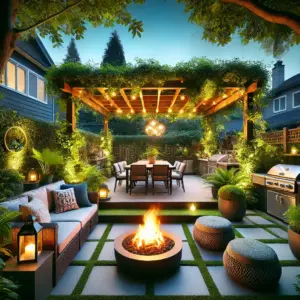Key Takeaways
- Discover how thoughtful landscaping design can turn any backyard into a personal oasis.
- Learn about various elements like plants, water features, and lighting that enhance outdoor spaces.
- Gain insights from experts on sustainable practices and innovative materials.
Table of Contents
- Introduction to Backyard Design
- Understanding Your Space and Needs
- Essential Elements of a Dream Backyard
- Plants and Greenery
- Water Features
- Outdoor Lighting
- Sustainable Landscape Practices
- Popular Trends in Backyard Design
- Bringing It All Together: Practical Steps for Implementation
- Real-Life Examples and Inspirations
- Tips for Maintaining Your New Backyard
Introduction to Backyard Design
A backyard is more than just a plot of land behind your home; it’s an open space that can become an extension of your living environment, imbued with personal touches and functionality. This outdoor canvas offers the perfect opportunity to blend nature with nurture, turning essentials like seating areas and pathways into integral parts of your lifestyle. Whether you’re imagining a private retreat or a hub for family activities, the tools and expertise of a backyard designer can transform even the most challenging spaces into dream escapes. Any backyard can be tailored to meet various desires and practical needs by employing creative strategies and innovative solutions. The goal is to create a cohesive space that reflects your style while providing a beautiful and functional haven.

Understanding Your Space and Needs
Before embarking on the journey of transforming your backyard, it’s critical to understand your space’s physical attributes and needs that must be met. Begin by taking measurements and noting the elements that add character or impose restrictions, such as mature trees, varying elevations, or existing hardscapes. Next, consider the practical wants and must-haves. Do you envision hosting lavish gatherings under the stars, or is an intimate, reflective garden more your speed? Does the space need to accommodate dynamic play areas for children or contain features that are supportive of a pet-friendly environment? Answering these questions helps steer the course and ensures that the final design integrates seamlessly with your lifestyle, balancing aesthetics and practicality. Mapping out zones for different functions and estimating budgetary requirements also play key roles in laying the groundwork for a successful design.
Essential Elements of a Dream Backyard
Plants and Greenery
The plant life you incorporate into your backyard is a living tapestry that changes with the seasons, providing a sense of rhythm and renewal. Strategic plant selection can significantly influence the ambiance, offering visual appeal and functional benefits such as shade, privacy, and habitat for local wildlife. When selecting greenery, consider layering trees, shrubs, and ground cover to establish a sense of depth and dimension. Indigenous plants frequently offer the most suitable choices because they acclimate to local climate and soil environments, which minimizes maintenance and promotes biodiversity. The diversity of plant textures and colors can also create a lively backdrop against which other backyard elements can stand out distinctively. Incorporate flowering plants for bursts of seasonal color, and remember that perennial species provide year-round interest while minimizing the need for constant replanting.
Water Features
Water features can bring an unmatched sense of tranquility to a backyard, changing it into a tranquil haven where the pressures of everyday life seem distant. Whether you opt for a natural pond, a babbling brook, or a dramatic waterfall, water introduces a dynamic element with a soothing auditory dimension and an opportunity to enhance the visual landscape. Artful placement of such features ensures they act as focal points, drawing attention and fostering a relaxing atmosphere. Adding aquatic plants or fish can further augment their impact, creating an interactive ecosystem that invites exploration and contemplation. Water features range from small, ready-made units to elaborate custom designs echoing the natural landscape, offering luxury and tranquility to enhance your backyard experience.
Outdoor Lighting
Effective lighting design not only extends the usability of your backyard into the evening hours but also highlights its beauty subtly and artfully. Outdoor lighting techniques, including uplighting, downlighting, accent lighting, silhouette key foliage, or architectural elements, provide the necessary illumination for safety and security. Today’s smart lighting options allow for customization and energy efficiency, offering control over brightness and color to create the desired mood. Solar lighting presents a sustainable choice that harnesses the sun’s power to illuminate pathways, gathering spots, and water features long after the sun has set, effortlessly blending eco-consciousness with elegance. Effective lighting can also provide opportunities to highlight unique landscape features, enhance security, and create zones for various evening activities, enhancing aesthetics and functionality.
Sustainable Landscape Practices
As environmental consciousness continues to rise, sustainable landscaping practices have gained prominence in modern backyard design, offering avenues to tread lightly on the planet while still achieving stunning, functional spaces. Implementing drought-resistant flora, installing drip irrigation systems, and harnessing rainwater reduce water consumption and align with global efforts to combat climate change. Utilizing recycled or locally sourced materials can decrease the carbon footprint of your project while providing authenticity and distinct appeal. Furthermore, designing with sustainability in mind can translate into cost savings and lower maintenance demands over time, making it both an eco-friendly and economical choice. Green roofs, permeable paving solutions, and composting facilities further enhance a sustainable approach, ensuring that your backyard complements its natural surroundings without compromising modern convenience.
Popular Trends in Backyard Design
Homeowners worldwide are embracing exciting trends that reflect a transition toward wellness-oriented, multifunctional backyard spaces. Vertical gardening is taking root, offering solutions for space-limited areas by incorporating living walls that beautify while emphasizing green spaces. Edible landscaping is also gaining traction, blending decorative plants with fruit-bearing and edible trees and bushes to combine aesthetics with practicality. The integration of smart technology now allows for seamless remote management of watering systems, lighting, and other landscape features, enhancing convenience and efficiency. These trends embrace a holistic approach, seeing backyards not just as external areas but as integral parts of daily living. More extensive features, such as outdoor kitchens, fire pits, and alfresco dining areas, underline the move towards creating multifunctional areas that enhance the quality of life by bringing interior comfort outdoors.
Bringing It All Together: Practical Steps for Implementation
- Begin by developing a detailed blueprint or digital mock-up of your planned design. This visual aid will guide decision-making and provide a clear path forward, ensuring that ideas are appropriately mapped out and potential challenges identified early on.
- Select materials and plant species based on durability, climate compatibility, and aesthetics, striving for a cohesive look that resonates with your desired style. Balancing eco-conscious choices with cost-effective options to achieve a sustainable yet modern design.
- Focus initially on structural work such as hardscaping, including patios, decks, and pathways, which form the backbone and circulation of your backyard design. This foundational work ensures a solid base upon which to build additional features.
- Carefully install your chosen plants and water features, ensuring they complement and enhance the overall layout while providing balance and interest. Consider plant selections’ long-term growth potential and maintenance requirements to fashion a resilient, lush garden.
- Conclude with lighting and decorative touches that tie the entire project together, transforming a layout into a personalized, inviting retreat. Accessories and elements such as outdoor furniture, sculptures, and planters add character and detail, helping to define the space as unique and yours.
Real-Life Examples and Inspirations
Perusing real-life transformations and success stories can ignite creativity and provide valuable insights into overcoming common design challenges. These examples showcase innovative solutions, from maximizing small spaces to creating multifunctional environments catering to diverse needs. They stand as proof of what can be accomplished through careful planning, imagination, and a readiness to challenge the limits of conventional landscape design. By examining how others have approached complicated situations and discovering unique approaches to marrying form and function, you can find inspiration and motivation to unlock your backyard’s full potential.
Tips for Maintaining Your New Backyard
With your dream backyard in place, maintaining its beauty and functionality is paramount to ensuring long-term enjoyment and value. Establishing and adhering to a seasonal maintenance routine will keep plants healthy and landscapes tidy. Routine tasks such as mulching, pruning, and cleaning hardscapes help preserve the integrity and appearance of your outdoor space. Keeping abreast of plant care—adjusting watering schedules and fertilization practices as necessary—ensures that your garden remains a thriving, colorful retreat that reflects the care and attention invested in it. Regularly monitoring and promptly addressing any issues will see your backyard blossom, providing a serene, beautiful escape for years. Periodically reassessing your garden’s needs and making necessary modifications will ensure that your outdoor sanctuary continues to grow and evolve alongside your lifestyle changes.



